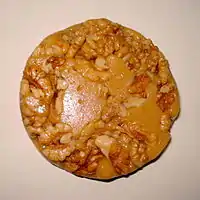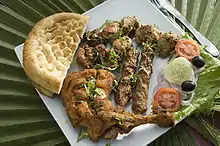Sohan halwa
Sohan halwa (Urdu سوہن حلوہ; [ˈsoːɦən ˈɦəlʋaː]) is a traditional Mughlai[1] dessert in South Asia, which is a variety of dense, sweet confection or halwa. Gheewala halwa is popular for sohan halwa since the Mughal era. There are hundreds of shops Pakistan that produce sohan halwa in the cities of Multan (Punjab), Dera Ismail Khan (Khyber Pakhtunkhwa).

 A variation of sohan halwa in the form of a circular disc | |
| Course | Dessert |
|---|---|
| Place of origin | West Asia and the South Asia |
| Main ingredients | cornflour, sugar, milk, water |
| Variations | Almonds |
| Other information | Halva |
It is made by boiling a mixture of water, sugar, milk, and cornflour until it becomes solid. Saffron is used for flavoring. Ghee is used to prevent it from sticking to the pan. Almonds, pistachios, and cardamom seeds are added. Unlike most other halwa dishes in the South Asia, it is solid, similar to its Middle Eastern counterparts.
History

In Old Delhi, in 1790, a Ghantewala sweet shop established during the reign of Mughal Emperor Shah Alam II made sohan halwa. It was a popular attraction,[2][3] but in 2015 it closed due to a lack of profitability.[4]
This sweet was originally called sohan in Khariboli (Hindi). The name is etymologically derived from the Sanskrit word shobhan. According to John T. Platts' Dictionary of Urdu, Classical Hindi and English, the sweet was named after one Sohan Lal.[5]
Commercial production
Sohan halwa has been commercially produced by traditional confectioners for decades. It is brittle and caramelised, usually made into discs of 5-6mm thickness or as square bite-size pieces. It is usually packaged in intricately designed tin cylinders. In recent years other packages have also been common.[6]
References
- "Not Butter Chicken, Delhi Was Once Renowned For Its Sohan Halwa, Brief History Of The Sweet". Slurrp. Retrieved 27 March 2022.
The Mughals, who were of Persian descent, made this [Sohan].
- Planet, Lonely. "Restaurants in Delhi, India".
- The royal treat in Chandni Chowk[Usurped!] The Hindu, Nov 07, 2002.
- "Ghantewala: Why did Delhi's 'oldest sweet shop' shut down?". BBC News. 24 July 2015.
- "A Dictionary of Urdu, Classical Hindi, and English". 1884.
- Ramazani, Nesta (1997). Persian Cooking: A Table Of Exotic Delights. Ibex Publishers, Inc. p. 296. ISBN 978-0-936347-77-6.
- Usman, Nizam Ud Deen. "Multani Sohan Halwa". Multani Sohan Halwa.
